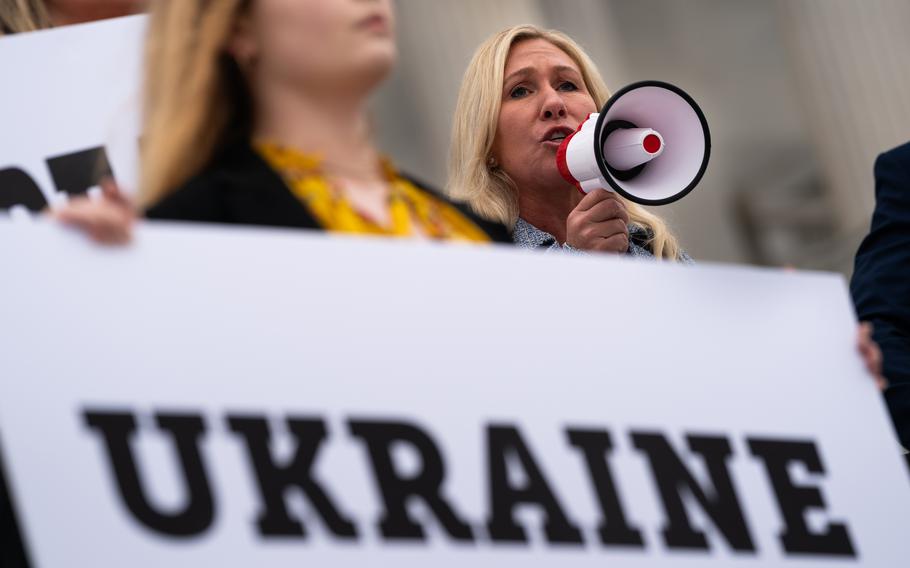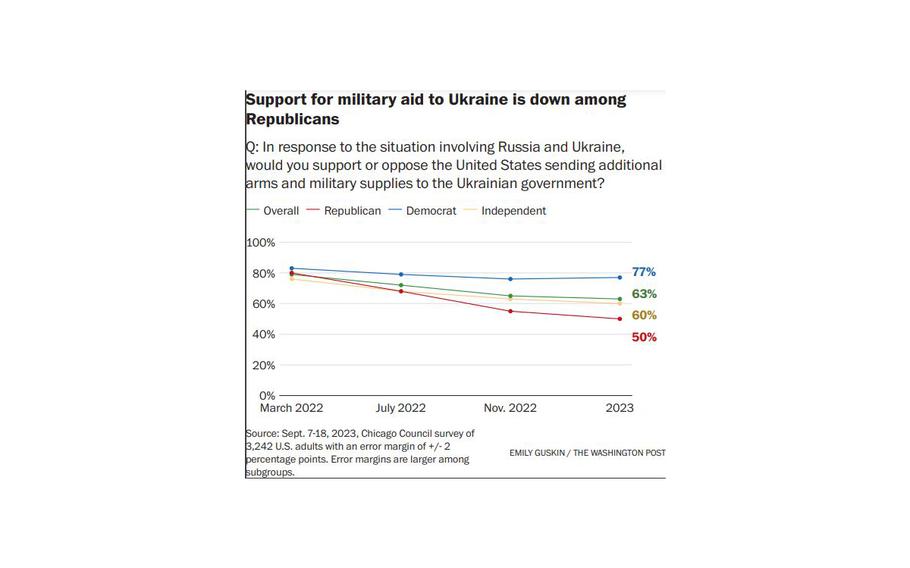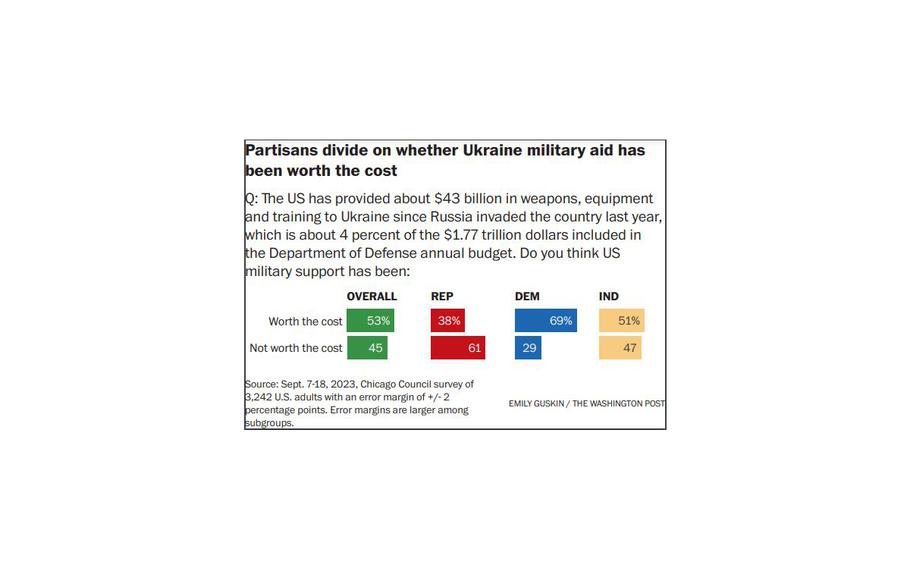U.S.
Most favor military aid to Ukraine, but partisan split grows, poll finds
The Washington Post October 5, 2023

Rep. Marjorie Taylor Greene (R-Ga.), speaking outside the U.S. Capitol late last month, has become one of the most outspoken opponents of providing additional U.S. funding to Ukraine. (Elizabeth Frantz/The Washington Post)
Nearly 20 months after Russia invaded Ukraine, bipartisan support for U.S. military assistance has frayed, according to a survey released Wednesday by the Chicago Council on Global Affairs. Most Americans still support sending additional arms and supplies to the Ukrainians, but more division exists over whether the investment has been worthwhile.
The findings come at a critical moment, as Ukraine, mired in a costly struggle to reclaim occupied territory, seeks further U.S. commitment with no end to the war in sight. President Biden has requested $13 billion in new military aid, but Republicans stripped the provision from the short-term spending bill approved Saturday hours ahead of a possible government shutdown.
The issue will remain one of the central debates in Washington as existing funds run out and lawmakers must decide whether to approve additional assistance amid growing opposition among Republicans. In Congress, most GOP leaders have expressed support for continuing to help Ukraine, but the latest survey data underscores the degree to which the party’s rank-and-file have either soured on or begun to question the mounting expense.
Overall, the Chicago Council poll found that 63 percent of U.S. adults support providing additional arms and military supplies to the Ukrainian government. That is comparable to 65 percent last November but down from 72 percent in July 2022.

(The Washington Post)
Among Republicans, support stands at 50 percent, a drop of 18 percentage points since July 2022 and 30 points since the opening weeks of Russia’s full-scale invasion. Democratic support stands at 77 percent, barely changed from 79 percent in the summer of 2022. Among independents, support has fallen eight points, to 60 percent.
The survey was conducted in mid-September, before Ukraine’s leader, Volodymyr Zelensky, traveled to the United States to press his country’s case at the United Nations and on Capitol Hill, where he faced GOP questions about how open-ended the conflict could become.
The Chicago Council poll found that 53 percent of Americans overall believe the infusion of U.S. weapons, equipment and training - totaling $43.9 billion since last year’s invasion, according to the Pentagon - has been worth the cost, compared with 45 percent who said it has not. Nearly 7 in 10 Democrats said the support has been worthwhile, while about 6 in 10 Republicans said it has not. Independents were divided about evenly on this question.
Americans are skeptical of the argument advanced by the Biden administration and others that supporting Ukraine militarily will deter aggression by other nations. The poll found 40 percent who said America’s backing of Ukraine would make powerful countries less likely to try to take over weaker countries elsewhere, while 20 percent thought such aggression will become more likely and 40 percent said U.S. assistance won’t make a difference.
Americans continue to express support for the NATO alliance, which has been strengthened as a result of the Ukraine war. About 3 in 4 (77 percent) said the United States should maintain or increase its commitment to NATO. That has ticked down from 81 percent in 2022 but is consistent with levels recorded over the past decade. Roughly 9 in 10 Democrats, along with about 7 in 10 independents and Republicans, support maintaining or increasing NATO commitments.
The poll tested opinions on two hypotheticals involving the NATO alliance: a Russian invasion of Germany and a Russian invasion of an ally like Latvia or Lithuania. The poll found 64 percent saying they would favor sending U.S. troops if Russia were to invade “a NATO ally like Germany,” while 57 percent said the same if Russia were to invade “a NATO ally like Latvia, Lithuania.”
Democrats are roughly equal in their support of defending Germany and Baltic allies, while Republicans are much more supportive of defending a country like Germany (64 percent) than one like Latvia, Lithuania or Estonia (48 percent).
Beyond partisan division on some of these questions, there is also a sharp split in support for Ukraine based on education. The Chicago Council poll found that 75 percent of college graduates support sending additional arms and military supplies to Ukraine, compared with 60 percent of those with some college education and 53 percent of those with high school degrees or less formal education. While 64 percent of college graduates said U.S. military aid has been worth the costs, that dropped to 49 percent for those with some college and 44 percent of those with a high school diploma or less.

(The Washington Post)
Apart from the Chicago Council poll, between 34 percent and 41 percent of Americans said in recent Post-ABC, Quinnipiac University and Fox News polls that the United States was providing too much assistance to Ukraine. These surveys found majorities or pluralities saying it’s the right amount or too little, though majorities of Republicans in recent polls said the United States was doing too much.
In absolute numbers, the United States has provided much more military and financial assistance than have other countries, though in terms of aid as a percentage of gross domestic product, smaller nations have done more.
Public opinion in the United States heavily favors mutual responsibility. Just 3 percent of adults in the Chicago Council poll said the United States has a greater responsibility than European countries have in helping Ukraine defend itself against Russia.
Overall, 66 percent said the United States and its European allies should be “equally responsible” for helping Ukraine and 30 percent said European countries should be more responsible. Among Republicans, 46 percent said European countries should be more responsible, while 52 percent said both should be equally responsible.
The Chicago Council poll found mixed support for aiding Ukraine indefinitely. One question found 49 percent agreeing that “The United States should urge Ukraine to settle for peace as soon as possible so that the costs aren’t so great for American households, even if that means that Ukraine will lose some territory.” A similar portion (47 percent) said the United States should support Ukraine as long as it takes, even if Americans have to pay higher gas and food prices as a result.
But a separate question that did not mention the sensitive issue of gas or food prices found greater support for long-term engagement. On that, 57 percent said, “The US should provide arms and military supplies to Ukraine until it reclaims all the territory that Russia has captured.” Meanwhile, 39 percent said, “The US should encourage Ukraine to negotiate with Russia to end the conflict, even if it means allowing Russia to keep territory it has captured in Ukraine.”
Most Americans, 55 percent, say neither Russia nor Ukraine has the advantage in the war, up from 46 percent last November. At that time, 26 percent said Ukraine had the advantage and an identical percentage said Russia had the advantage. Since then, perceptions of Ukraine’s standing has slipped, with 29 percent saying Russia has the advantage and 14 percent giving the edge militarily to the Ukrainians.
Few expect a forthcoming end to the conflict, with 34 percent saying the fighting will go on for “over a year,” another 34 percent saying it will last two to four years more and 15 percent saying it will last five years or more. Zelensky continues to be popular in the United States, with 67 percent rating him favorably, down from 81 percent in March 2022. His ratings among Republicans have fallen 26 points over that period, but 55 percent continue to have a positive impression of him, as do 61 percent of independents and 84 percent of Democrats.
Americans are nearly united in blaming Russian President Vladimir Putin for the war, with about 9 in 10 Democrats, Republicans and independents saying he deserves “a great deal” or “a fair amount” of blame. Overall, about 3 in 10 blamed NATO and 3 in 10 blamed Zelensky while 1 in 4 blame the United States.
The Chicago Council survey was conducted online Sept. 7-18 among 3,242 adults nationwide. The sample was drawn through Ipsos’s KnowledgePanel, an ongoing survey panel recruited through random sampling of U.S. households. The margin of sampling error for overall results is plus or minus two percentage points.